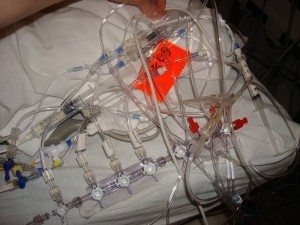SAN JOSE, CA – It took over 3 years and 7 months to do, but the intensive care unit (ICU) team at Holy Cross Hospital is ecstatic to report that it has finally untangled all those wires, and the patient is finally ready to transfer to the floor.

“I still remember the day, November 6, 2013, like it was yesterday,” began ICU nurse Samantha Watkins. “The patient came out of the OR with peripheral lines, central lines, telemetry, numerous drips, Foleys, drains, you name it! The patient was a human ball of yarn. If there’s something I like more than untangling my iPhone ear buds when I take them out of my pocket, it’s untangling all these patient wires.”
According to Watkins, it took nearly every second, minute, and hour of the past 43 months to untangle all of the wires. It was more delicate than even the most complex of neurosurgeries.
Watkins laid out the time line for Gomerblog.
“2014 was dedicated to identifying the Foley,” she explained. “2015 was focused on separating the telemetry wires and IVs without dislodging any drains or NG tubes. 2016 was all about weaning the vasopressors. As for 2017, we have to give credit to the patient; he self-extubated and yanked out his Foley. Voila! Just like that, he’s untangled and ready to transfer out.”
Hospitalist Wendy Han will be taking over the care of the patient.
“Our ICU team is the best, no ICU team can untangle wires like ours,” Han said proudly of her ICU team. Han went on to say that the team even took the time to prepare a transfer summary of the patient’s near 4-year stay, with over 85% of the text dedicated to the untangling process.
Because the separation of tubing and wires was so time-intensive, it should be without surprise that Gomerblog reports that neither Han nor the ICU team have any idea what’s going on with the patient, but most definitely needs placement.